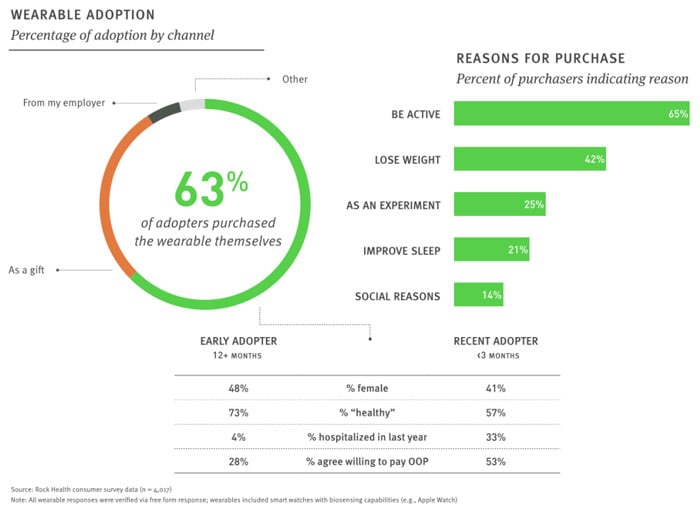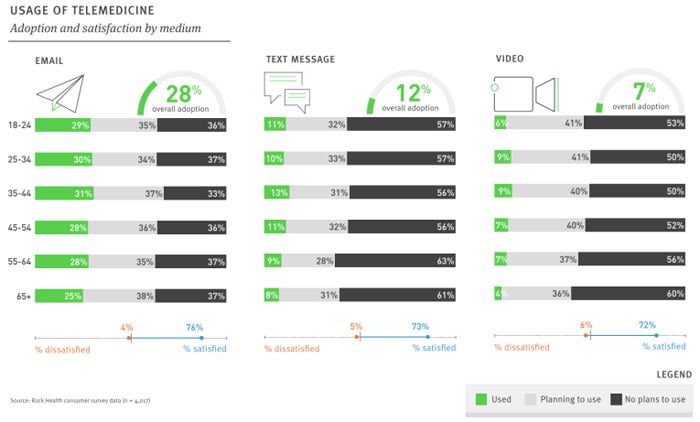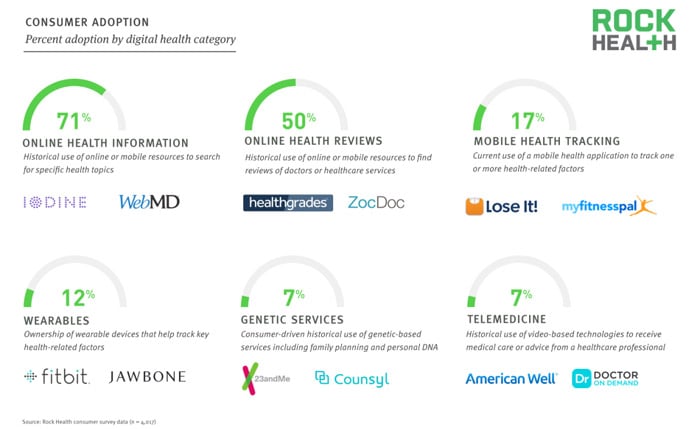Rock Health released a new report on consumer health trends suggesting that 80 percent of internet-connected adults use some kind of digital health technology, while 2 percent were “super adopters” using all kinds of services.
The venture fund dedicated to digital health identified six different “kinds of services” of digital health use: searching for online health information, comparing health services online, tracking health with a mobile app, tracking health with a wearable device, telemedicine, and using consumer-facing genetic services.
The survey involved 4,000 internet-connected adults, 92% of which think they should be the one to control their health data.The survey involved 4,000 internet-connected adults, more than half of which said they felt somewhat responsible for their own health.
“While 52 percent of consumers strongly agree they are responsible for their own health, only 7 percent would say the same about their willingness to pay out-of-pocket for healthcare,” report authors Malay Gandhi and Teresa Wang wrote, noting that 31 percent say they are “actively taking care of their health.”
![]()
By far, most users (71%) search online for health information, while 50 percent used online health reviews. The most common search was for prescription drug information, followed by searches for a medical diagnosis, information on supplements, and searches for treatment options for patients with an existing diagnosis.
Searches in the last mentioned group were most actionable, with 45 percent of those who searched for a diagnosis proposed that diagnosis to their physician. Overall, 40 percent of people who made an online search for health information acted on the results of their search in some way.
When it comes to reviews, respondents were most likely to search for physician (44%) and hospital (33%) reviews, followed by nursing homes (10%) and professional caregivers (7%).
Just 17% of respondents used health tracking apps and only 12% used wearables.Just 17 percent of respondents used health tracking apps and only 12 percent used wearables. Of those that use these apps and devices, most used to track their physical activity.
Rock has also found that 63 percent of wearable owners bought the device for themselves, but 25 percent of them said they did so “as an experiment.”

“There are likely two major contributors to the attrition and rapid engagement decay rates noted in many other surveys,” Rock Health authors wrote. “First, 28 percent of individuals are receiving wearables as a gift; and second, of those who purchase, 25 percent cite that they are doing so as an experiment. The implication of the second reason is that they do not set out with long-term ownership interest.”
Only 7 percent of respondents used telemedicine, and they were more apt to use email or texting than video to interact with doctors. Email also has the highest adoption (28 percent) and the highest satisfaction (76 percent), followed by text messaging (12% adoption and 73% satisfaction), and video visits (7% adoption and 72% satisfaction).

Finally, Rock found that most (92%) users in its survey think they should be the one to control their health data. Nevertheless, they are willing to share that data to get better care from their doctor (80%), contribute to medical research (59%), get a more affordable health insurance (52%); finally, 39% would just sell it for money – with no information about how it would be used.
[Via: mobihealthnews]


